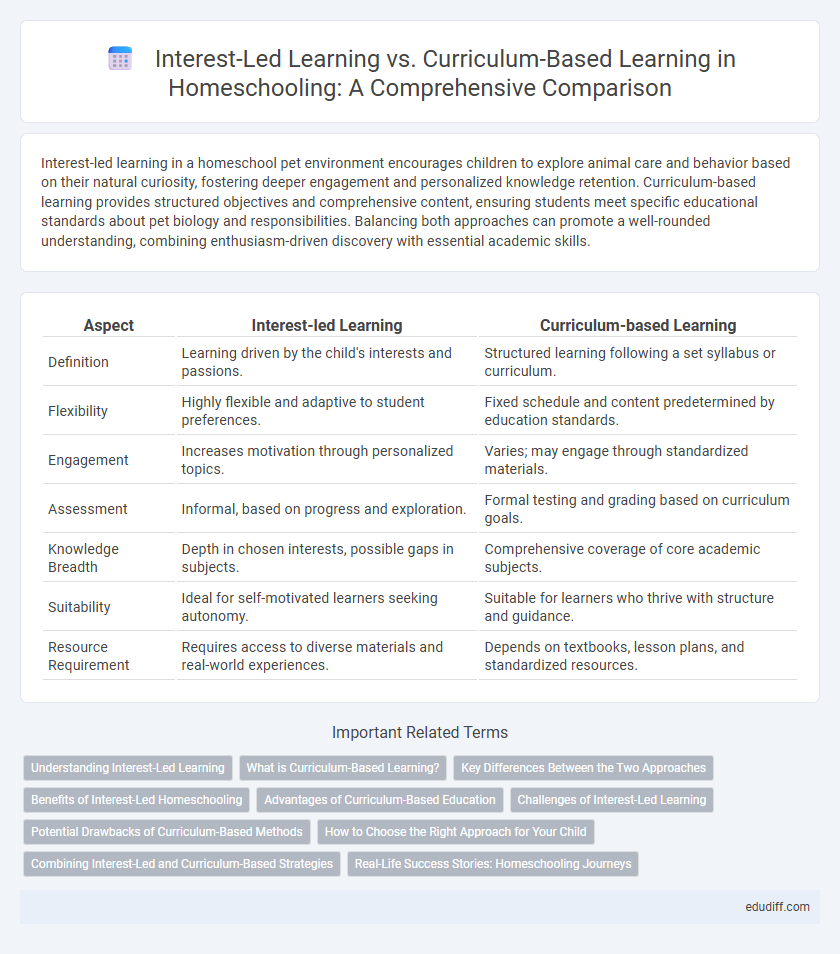Interest-led learning in a homeschool pet environment encourages children to explore animal care and behavior based on their natural curiosity, fostering deeper engagement and personalized knowledge retention. Curriculum-based learning provides structured objectives and comprehensive content, ensuring students meet specific educational standards about pet biology and responsibilities. Balancing both approaches can promote a well-rounded understanding, combining enthusiasm-driven discovery with essential academic skills.
Table of Comparison
| Aspect | Interest-led Learning | Curriculum-based Learning |
|---|---|---|
| Definition | Learning driven by the child's interests and passions. | Structured learning following a set syllabus or curriculum. |
| Flexibility | Highly flexible and adaptive to student preferences. | Fixed schedule and content predetermined by education standards. |
| Engagement | Increases motivation through personalized topics. | Varies; may engage through standardized materials. |
| Assessment | Informal, based on progress and exploration. | Formal testing and grading based on curriculum goals. |
| Knowledge Breadth | Depth in chosen interests, possible gaps in subjects. | Comprehensive coverage of core academic subjects. |
| Suitability | Ideal for self-motivated learners seeking autonomy. | Suitable for learners who thrive with structure and guidance. |
| Resource Requirement | Requires access to diverse materials and real-world experiences. | Depends on textbooks, lesson plans, and standardized resources. |
Understanding Interest-Led Learning
Interest-led learning emphasizes student curiosity and intrinsic motivation, allowing learners to explore subjects deeply based on their passions. This approach fosters creativity, critical thinking, and personalized educational experiences that adapt to the learner's pace and interests. Research shows interest-led learning enhances engagement and retention by connecting education to real-world relevance and personal meaning.
What is Curriculum-Based Learning?
Curriculum-based learning follows a structured educational framework with predefined objectives, lessons, and assessments designed to ensure consistent knowledge acquisition across subjects. This approach emphasizes standardized content delivery, enabling measurable progress and alignment with academic standards. It supports comprehensive coverage of essential skills and concepts within a specific timeline, often used in both traditional and homeschool settings.
Key Differences Between the Two Approaches
Interest-led learning centers on the student's passions and curiosity, fostering intrinsic motivation and personalized exploration, while curriculum-based learning follows a structured, pre-designed syllabus aimed at meeting standardized educational goals. Interest-led learning offers flexibility and adaptability, allowing learners to dive deeper into topics they find engaging, whereas curriculum-based learning ensures comprehensive coverage of subjects aligned with academic standards. The key difference lies in the balance between student autonomy and systematic progression through predefined knowledge benchmarks.
Benefits of Interest-Led Homeschooling
Interest-led homeschooling cultivates intrinsic motivation by allowing children to explore subjects aligned with their passions, fostering deeper engagement and long-term retention. This personalized learning approach adapts to each child's unique pace and style, enhancing creativity and critical thinking skills. Research indicates that students thriving in interest-led environments often develop stronger problem-solving abilities and increased self-directed learning habits compared to traditional curriculum-based learners.
Advantages of Curriculum-Based Education
Curriculum-based education offers structured learning paths with clear objectives, ensuring comprehensive coverage of essential academic subjects. It facilitates standardized assessment and progress tracking, allowing parents to monitor performance against established benchmarks. This approach supports consistent knowledge acquisition and prepares students for formal examinations and future academic pursuits.
Challenges of Interest-Led Learning
Interest-led learning in homeschooling often faces challenges such as inconsistent knowledge acquisition due to a lack of structured curriculum, making it difficult to track progress and meet educational standards. Students might experience gaps in foundational subjects like math and science when their interests do not naturally align with these areas. Parents also encounter difficulties balancing children's enthusiasm with necessary skill development, requiring additional effort in resource selection and time management.
Potential Drawbacks of Curriculum-Based Methods
Curriculum-based learning in homeschooling can limit flexibility, potentially stifling a child's natural curiosity and intrinsic motivation. It often emphasizes standardized content and pacing, which may not accommodate individual learning styles or developmental readiness. This rigid structure risks disengagement and frustration, reducing the effectiveness of personalized education.
How to Choose the Right Approach for Your Child
Choosing the right homeschooling approach depends on your child's learning style, interests, and developmental needs. Interest-led learning fosters intrinsic motivation by allowing children to explore topics they are passionate about, enhancing engagement and creativity. Curriculum-based learning provides structured guidance and measurable progress, which can benefit children who thrive with clear expectations and systematic instruction.
Combining Interest-Led and Curriculum-Based Strategies
Combining interest-led and curriculum-based strategies in homeschooling enhances student engagement by aligning academic goals with personal passions, resulting in deeper understanding and retention. Structured curriculum provides essential skills and knowledge frameworks, while interest-led activities foster creativity and intrinsic motivation. This blended approach supports individualized learning paths that adapt to evolving student interests without compromising educational standards.
Real-Life Success Stories: Homeschooling Journeys
Interest-led learning fosters personalized engagement and deep understanding by allowing students to explore subjects aligned with their passions, often leading to innovative career paths and entrepreneurial ventures. Curriculum-based learning provides structured knowledge acquisition, ensuring comprehensive coverage of essential skills and standardized academic benchmarks crucial for higher education and professional certification. Numerous homeschooling success stories highlight individuals who excelled through interest-led approaches by launching startups or pursuing unique careers, while others thrived using curriculum-based methods to gain college admissions and scholarships.
Interest-led Learning vs Curriculum-based Learning Infographic

 edudiff.com
edudiff.com